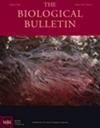食虫幼虫与其他棘皮动物幼虫发育可塑性的比较
IF 2.1
4区 生物学
Q2 BIOLOGY
引用次数: 0
摘要
采食棘皮动物的幼虫对食物的适应性发育可塑性表现出不同的范围。由骨杆支撑的窄臂上纤毛带的延长,如针鼹类和蛇卵类幼虫,可能会使每个细胞的最大清除率增加得更多,在食物稀缺时,发育更长的纤毛带具有更大的优势。幼鱼的口部和水维管系统在新位置的形成,如棘刺类和小行星幼虫,允许幼鱼在摄食期间广泛生长,当食物充足时,幼鱼的生长时间更早或更长。相反,营养物质储存的可塑性与纤毛带的形状或幼鱼嘴的形成部位无关。摄食的holothuroids幼虫(auriculariae)缺乏由骨杆支撑的手臂和在新位置形成的嘴,但作为一个独特的特征,营养物质储存在透明的球体中。在本研究中,对加利福尼亚背刺木耳的摄食越多,幼木耳的体长、体宽、透明球越大,但摄食对大部分木耳身体部位大小的影响较小。食粮较多的木耳胃相对较大,后部透明球较大,表明营养储存较多。食粮较少的木耳,其口部相对较宽,在某些外形尺寸上也存在差异,这可能有利于食粮的捕获。可塑性在初级发育和摄食结构中受到限制,但营养储存的可塑性可以在摄食幼虫的生长时间和变态形成的幼鱼的条件之间提供有利的折衷。本文章由计算机程序翻译,如有差异,请以英文原文为准。
Scope for Developmental Plasticity of Feeding Larvae of a Holothuroid, Contrasted with Other Echinoderm Larvae
Feeding larvae of echinoderms appear to differ in scope for adaptive developmental plasticity in response to food. Extension of the ciliary band on narrow arms supported by skeletal rods, as in echinoid and ophiuroid larvae, may enable a greater increase in maximum clearance rate per cell added, conferring greater advantages from developing longer ciliary bands when food is scarce. Formation of the juvenile mouth and water vascular system at a new site, as in echinoid and asteroid larvae, permits extensive growth of the juvenile rudiment during larval feeding, with advantages from earlier or more growth of the rudiment when food is abundant. In contrast, plasticity in storage of nutrients is unrelated to the form of the ciliary band or the site of formation of the juvenile’s mouth. Feeding larvae (auriculariae) of holothuroids lack arms supported by skeletal rods and formation of the mouth at a new site but as a unique feature store nutrients in hyaline spheres. In this study, more food for auriculariae of Apostichopus californicus resulted in juveniles (pentactulae) with longer and wider bodies and larger hyaline spheres, but effects of food supply on the size of most body parts of auriculariae were small. Auriculariae with more food developed relatively larger stomachs and larger posterior hyaline spheres, indications of greater nutrient storage. Auriculariae with less food developed relatively wider mouths and differed in some exterior dimensions, which might enhance the capture of food. Plasticity is limited in rudiment development and perhaps in structures for feeding, but plasticity in nutrient storage can provide advantageous compromises between duration of growth as a feeding larva and the condition of juveniles formed at metamorphosis.
求助全文
通过发布文献求助,成功后即可免费获取论文全文。
去求助
来源期刊

Biological Bulletin
生物-海洋与淡水生物学
CiteScore
3.30
自引率
6.20%
发文量
47
审稿时长
6-12 weeks
期刊介绍:
The Biological Bulletin disseminates novel scientific results in broadly related fields of biology in keeping with more than 100 years of a tradition of excellence. The Bulletin publishes outstanding original research with an overarching goal of explaining how organisms develop, function, and evolve in their natural environments. To that end, the journal publishes papers in the fields of Neurobiology and Behavior, Physiology and Biomechanics, Ecology and Evolution, Development and Reproduction, Cell Biology, Symbiosis and Systematics. The Bulletin emphasizes basic research on marine model systems but includes articles of an interdisciplinary nature when appropriate.
 求助内容:
求助内容: 应助结果提醒方式:
应助结果提醒方式:


